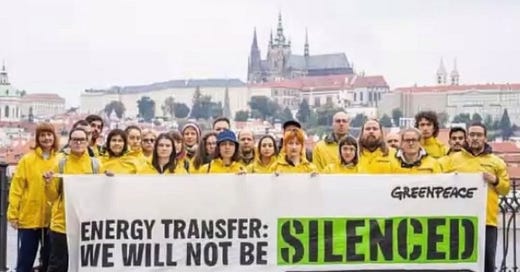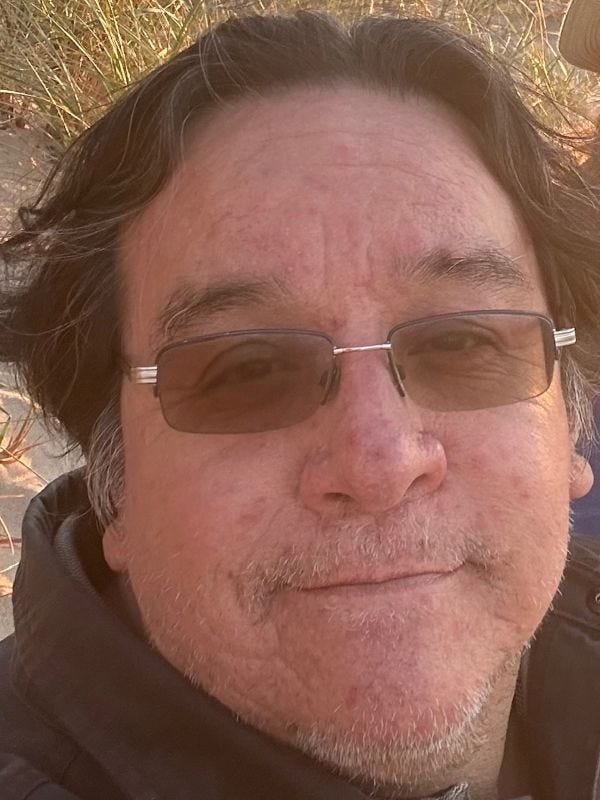Yet another blow to Standing Rock Sioux
Decision against Greenpeace adds more injury to Lakota tribe's struggle
An image shared during a Greenpeace webinar on Thursday.
Anthony “Guy” Lopez sipped his diner coffee as he shared with me some of his memories from the area where Energy Transfer Partners pushed a pipeline under the Missouri River in North Dakota—an action that in 2016 inspired a strong resistance around the Standing Rock Sioux Reservation.
As a federal employee, Lopez played a role in getting relevant information out to the tribal nations located along the then-proposed path of the Dakota Access Pipeline, or DAPL (pronounced “dapple”). But as a child, he witnessed the devastation from the federal take-over of the land along the Missouri River later designated for the pipeline’s path.
The oil transport company’s overreactive response to the movement drew allies from around the nation, Indigenous and non-Indigenous alike. On Wednesday, a North Dakota court ridiculously fined Greenpeace $660 million for its minor participation in the movement. The non-profit environmental group plans to appeal.
Earlier this month, I described how Greenpeace played only a minor role in the Standing Rock movement’s youth-led launch and grassroots growth centered around Indigenous solidarity. Here, I want to share some background on the bigger struggle that many of us non-Indigenous people likely missed.
Dammed land
Some of his earliest memories come from around the reservoir created by Big Bend Dam, started in 1959. It was the last of five dams the Army Corps of Engineers installed on forcibly confiscated tribal lands.
“I remember as a kid, the water was still expanding. They flooded a lot of trees, a lot of forests. And there were a lot of dead trees sticking up out of the water,” said Lopez, a friend who has helped me understand Indigenous issues since I first met him in Tucson in 1996. “I remember it was eerie to drive along the river and see all the dead trees, and dead forests.”
In the 1960s, he and his friends and relatives would cling to one of the bigger logs for a floating raft, kicking in unison to move it around the reservoir.
The riverside area around that South Dakota dam belonged to his maternal tribe, the Crow Creek Sioux. It was only a year older than the Missouri River’s Oahe Dam designated for DAPL passage, on the lands of the nearby Standing Rock Sioux Reservation straddling North and South Dakota.
As he grew older, the reservoir came to symbolize something more than a place to splash around.
With a father in the military, his life became more nomadic. But on family visits back to their South Dakota roots, he’d find fewer and fewer cousins and other family members there to welcome him home.
Once he learned some of the history of his tribal nation, he understood why. The construction of the five dams on 550 square miles of lands belonging to the Lakota/Dakota peoples coincided with a massive government effort to relocate the members of the tribe historically known as Sioux.
“Something like a third of the Sioux Indians were relocated. A lot of the young people. That’s how we ended up in the urban setting,” Lopez said. “That’s how a lot of my relatives ended up in Denver and Los Angeles and Minneapolis, Chicago, and Dallas—because it was a government policy to occupy our lands and push people out.”
Keep in mind we are talking about the 1960s here. This is not ancient history.
Dams flood fertile lands
The construction of the series of earthen dams fell under the Pick-Sloan Flood Control Act of 1948. Michael Lawson, author of Dammed Indians: The Pick-Sloan Plan and the Missouri River Sioux, 1944-1980, stated the plan "did more damage to Indian land than any other public works project in America" and that the Sioux people derived little benefit from it.
Lopez agrees. The land grabbed included some of the most fertile in the state, with high biodiversity and expansive forests as well as gardens that made food sovereignty a reality rather than a distant dream.
The electricity from the dams that displaced so many Lakota/Dakota families doesn’t even benefit the displaced tribes, he noted. Instead, it provides electricity for distant cities.
Anthony “Guy” Lopez
Although his voice remained calm, I could hear some frustration seeping into it. I had to remind myself to close my dropped jaw as he continued sharing his thoughts over a breakfast of eggs and toast.
If the government had worked with the involved tribes to reach agreements, Lopez said, they might have at least negotiated some benefit—perhaps a share of some of the electricity sale profits in exchange for the 352,000 acres of land confiscated. Then they could have used that money to re-establish their communities elsewhere.
“But it wasn’t like that,” he said. “It was like, the government came in and said, ‘We’re going to take their reservation lands and treaty lands, and then we’re going to fight tooth and nail to stop them from benefitting at all and we’re going to just relocate them to the cities.’ ”
The U.S. Army Corps of Engineers buried hundreds of homes of the Standing Rock Sioux Lakota and self-sustaining gardens under water, providing little compensation except to those willing to relocate.
So that provides some modern context for the modern assault on the Lakota/Dakota peoples, and why they felt such a strong need to protect the land and water designed for pipeline construction. Remember, these homeowners and tribal members were never asked permission about flooding the land ceded to them by treaty, and they never gave it.
More land grabs
Alas, there’s more.
The Dakota from Crow Creek Sioux Reservation, the Lakota from Standing Rock Sioux Reservation, and many other related tribes had originally shared the Great Sioux Reservation stretching across much of the land now hosting the pipeline. The larger area, which includes Nakota as well as Lakota and Dakota tribes, are known as the Oceti Sakowin—the Seven Council Fires.
In the 1968 Treaty of Fort Laramie, the federal government established the Great Sioux Reservation across much of South Dakota and Nebraska as well as portions of North Dakota, Wyoming and Montana for the related tribes’ “absolute and undisturbed use and occupation.”
The Great Sioux Reservation (as defined in the 1851 predecessor to the 1868 treaty) in the context of DAPL. Map designed by cartographer Carl Sack.
A mere eight years later, the federal government violated the treaty to confiscate land that included the Black Hills of South Dakota. More than a century after that, the U.S. Supreme Court ruled in 1980 that the United States owed the Sioux $102 million for the stolen land.
The court’s opinion on that theft stated, “A more ripe and rank case of dishonorable dealings will never, in all probability, be found in our history,” reported a High Country News story by Nick Tilsen, the author of Our History is the Future: Standing Rock Versus the Dakota Access Pipeline, and the Long Tradition of Indigenous Resistance.
With interest and inflation, Tilsen notes that money is now worth nearly $2 billion—but the Lakota/Dakota tribes continue to reject the pay off. They just want their traditional homelands back.
“With the DAPL pipeline, there were known cultural sites and burial sites and it was going through treaty lands that had never been relinquished,” Lopez said.
So that’s some of the historical context on the land used and abused by Energy Transfer. Its DAPL project itself added a new layer of the government forcing itself on the Lakota/Dakota peoples. Many link its oil-carrying pipeline to a legendary “black snake” that would bring problems and despair unless vanquished by the Seventh Generation—roughly, modern-day Millennials.
A Corps problem
As with the dam construction, the U.S. Army Corps of Engineers played a defining role in the pipeline and its threat to the tribe’s water.
Lopez found himself involved in the case as a federal Advisory Council on Historic Preservation specialist. The Corps had divided the project into a series of smaller projects, with hundreds of sites with potential historic or cultural relevance being considered individually.
He realized some of the affected tribal nations’ historic preservation officers might overlook yet another piece of bureaucratic paperwork coming across their desks, so he made it a point to share information on the larger project in a cohesive way so they could recognize the bigger picture.
Lopez also contributed to writing a May 19, 2016, letter from the Advisory Council on Historic Preservation to Army Corps head Thomas P. Bostick, stating:
“…the ACHP is concerned that the Corps’ focus on individual PCN [209 water] crossings as separate undertakings, and the segmented oversight by three Corps districts and a Corps Civil Works facility has resulted in disjointed and inadequate consultation with Indian tribes who may ascribe religious and cultural significance to historic properties that may be affected by the undertaking.”
The letter followed on the heels of the April 24 run by Lakota/Dakota youth to deliver their own letter to the Army Corps and to bring attention to the planned dangers of the pipeline.
Once the pipeline project started gaining media attention, it was handed over to a more senior advisory council specialist with experience in handling controversial projects. He retired from the position in 2022, although he still lives in Virginia.
Lopez blamed the Corps, Energy Transfer Partners and its consultants on the disjointed nature of the project. He believes that played a role in the Standing Rock response to the project, with a demonstration camp set up in and around Cannonball, North Dakota.
“The protest camp, I guess it was a reaction to the threat to the water,” he said. “But it was also a reaction to this unmanageable scenario, from the tribes’ point of view. Because they couldn’t afford to engage on every undertaking over three districts—like, they’d be talking to three different Corps agency officials.”
Over the next half a year, tens of thousands of people, including veterans and celebrities as well as representatives of tribal nations from across the country, visited the camp to demonstrate their support. In late 2016, the Obama administration issued an executive order to nix the pipeline.
However, then-incoming president Donald Trump quickly pushed it through once he started his term in 2017. Energy Transfer Partners is currently operating the pipeline, even though it has yet to finish the environmental impact statement required for its operation.
Despite the bad ending, Lopez and others believe the sense of solidarity the pipeline initiated among the splintered Seven Council Fires was a step in the right direction, especially for Indigenous youth.
“DAPL, the protest brought together the Oceti Sakowin,” he said. “It was a historic moment in time because they had all these young Indigenous people standing up for the water, which was their essence—literally what they were made of.”
Western science echoes the Indigenous knowledge that water is a crucial component of life. Depending on age and other factors, human beings are composed of between half and 75 percent water.
Now let’s just hope the pipeline doesn’t leak as it passes through the river that provides them the drinking water they need to replenish their essence. The vital people of the Standing Rock Sioux Reservation and their relatives, like everyone else, deserve water untainted with oil.
This country has already stolen so much of their land. It would be nice if we could leave them some potable water.
Until this case is overturned, it leaves we Americans dealing with yet another blow to free speech and our ability to protect ourselves from potential dangers such as tainted water. To donate to Greenpeace, click here. To to learn more by participating in the group’s Thursday webinars, go here. For more background on the lawsuit, go here.






